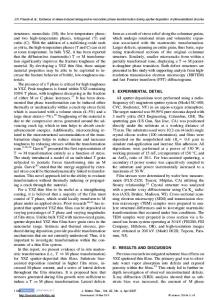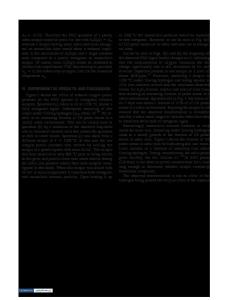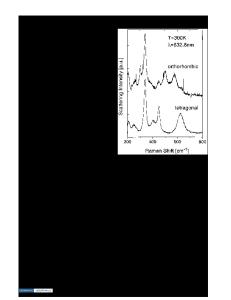Size-Induced Tetragonal to Monoclinic Phase Transition in Zirconia Nanocrystals
- PDF / 685,775 Bytes
- 6 Pages / 612 x 792 pts (letter) Page_size
- 9 Downloads / 336 Views
Q5.2.1
Size-Induced Tetragonal to Monoclinic Phase Transition in Zirconia Nanocrystals. Gianguido Baldinozzi1, David Simeone1,2, Dominique Gosset2, Michael Dutheil2 and Jan Kusinski3,1 1
SPMS, UMR 8580 CNRS-Ecole Centrale Paris, Grande voie des vignes, 92295 ChâtenayMalabry, FR. [email protected] 2 SRMA, CEA Saclay, 91191 Gif-sur-Yvette, FR. [email protected] 3 Academy of Mining and Metallurgy, AGH Krakow, PL ABSTRACT Accurate neutron powder diffraction experiments at D20, ILL Grenoble, allowed to monitor the reconstructive tetragonal to monoclinic phase transition as a function of the size of zirconia nanoparticles. In the nanocrystals, both phases are identical to the ones generally observed in micrometric zirconia. Rietveld refinements on these samples point out an increase of the tetragonal fraction and a decrease of the lattice parameters when the size of the particle decreases. An uniaxial strain depending on the grain size is also observed. The phase transition definitely occurs above a threshold crystal size. These results are analysed within the Landau theory and they can be understood as a mechanism of size-dependent phase transition where the primary order parameter is altered by the nanoparticle size. INTRODUCTION It is well known that micrometric grains of zirconia are monoclinic at room temperature and under normal pressure. A reversible first order phase transition is observed at about 1200 K towards a tetragonal phase [1] that cannot be quenched at room temperature [2,3]. It is also well known that this tetragonal phase can be observed at room temperature in zirconia nanoparticles [4] of less than 30 nm diameter. Several authors [5,6] confirm these observations and others report observations of metastable phases in various materials such as alumina [7] and graphite [8]. The existence of stabilized phases in very fine powders is generally explained in terms of a surface free energy in the nanocrystalline tetragonal phase lower than in the normal phase [9]. Nevertheless, this explanation is not generally accepted [10] and some authors report either the appearance of 6 nm diameter monoclinic zirconia nanoparticles [11] or they do not relate the decreasing of the tetragonal phase to the increase in the grain size of zirconia nanoparticles [5]. The main reasons for these controversial opinions seem related to extrinsic factors like the presence of impurities [12,13] and to the existence of residual stresses in the nanoparticle agglomerates [14]. How is the grain size really acting on this phase transition? Is it possible to describe this first order phase transition within a Landau theory formalism? Is the grain size a primary order parameter in the Landau free energy expansion? To clarify this complex picture, it is necessary to perform accurate experiments on very pure samples where the effect of particle size, the pertinent parameter, can be clearly identified. In fact, following the transformation kinetics in zirconia nanocrystals allows a straightforward interpretation of the experimental r
Data Loading...











